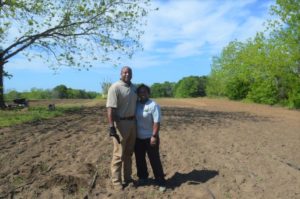
Leslie and Jarrod raise cattle and grow a variety of vegetables on their Henry County farm.
By Cassondra Searight, Alabama FSA Public Affairs Specialist
Jarrod and Leslie Dozier, owners of 3D Farms in Henry County, Alabama, work diligently to grow and sustain their family farm, which has been in Leslie’s family for over 100 years. What started as a cattle operation and pine trees, grown as part of the USDA Farm Service Agency’s (FSA) Conservation Reserve Program (CRP), has now evolved into a thriving and diversified operation to include the production and sale of fresh produce.
Leslie and Jarrod became the co-operators of the family farm in 2009, after Leslie’s father passed away. Keeping up the 45-head cattle operation was no small task for them since they both work full time jobs off the farm, but they knew they wanted to do more.
“My husband was a farm newbie and kind of married into it,” Leslie said.
In 2016, Jarrod and Leslie decided to try their hand with vegetable crops. Recognizing and accepting that failure was possible, they considered the first year as their experiment. They knew the key to success in the humid Alabama climate was irrigation and good soil quality. Knowing this, they decided to install a drip irrigation system and chose a piece of farmland that had not been in production for years but was rich in nutrients.
Their experiment turned out to be a huge success and demand for their produce was higher than they could have imagined. Today, their vegetable operation consists of two to three acres. They grow a variety of crops including tomatoes, potatoes, eggplant, squash, onions, collards, turnips and many other vegetables to sell at their local farmers market and directly to customers visiting the farm.
“I was born to be a farmer,” Jarrod said. “I hope to transition from working full time off the farm to becoming a full-time farmer.”

Keeping up the 45-head cattle operation is no small task for the Doziers, as they both work full time jobs off the farm.
Jarrod and Leslie credit their success to their faith, resilience, patience, research, planning, sustainable growth, and the availability of USDA programs and resources.
Droughts in 2016 and 2017 lead the Doziers to apply for FSA’s Livestock Forage Disaster Assistance Program (LFP), which provides livestock producers with assistance for grazing losses due to drought. To protect their grazing land from future disasters, they are also enrolled in the Noninsured Crop Disaster Assistance Program (NAP). NAP provides financial assistance to producers of noninsurable crops when low yields, loss of inventory, or prevented planting occur due to natural disasters, allowing them to manage risk on their farm.
In addition to their involvement with FSA programs, Jarrod serves as a minority advisor on his local FSA county committee. Jarrod and Leslie are also working to become Good Agricultural Practices (GAP) certified. GAP is a voluntary audit that verifies that fruits and vegetables are produced, packed, handled, and stored as safely as possible to minimize risks of microbial food safety hazards.
They are also certified to accept Supplemental Nutrition Assistance Program (SNAP) benefits through the USDA Food and Nutrition Service, making their fresh produce available to a broader customer base.
“3D Farms’ [vision] is to be sustainable in growing top-notch produce and helping the environment and the community understand the benefits of eating fresh vegetables,” Jarrod said. “3D Farms wants to be an asset to the community.”
To learn more about USDA’s programs for new and beginning farmers, contact your local FSA office or visit www.fsa.usda.gov. To find your local FSA office, visit www.farmers.gov.






3 Responses to Transitioning from Trees to Leaves